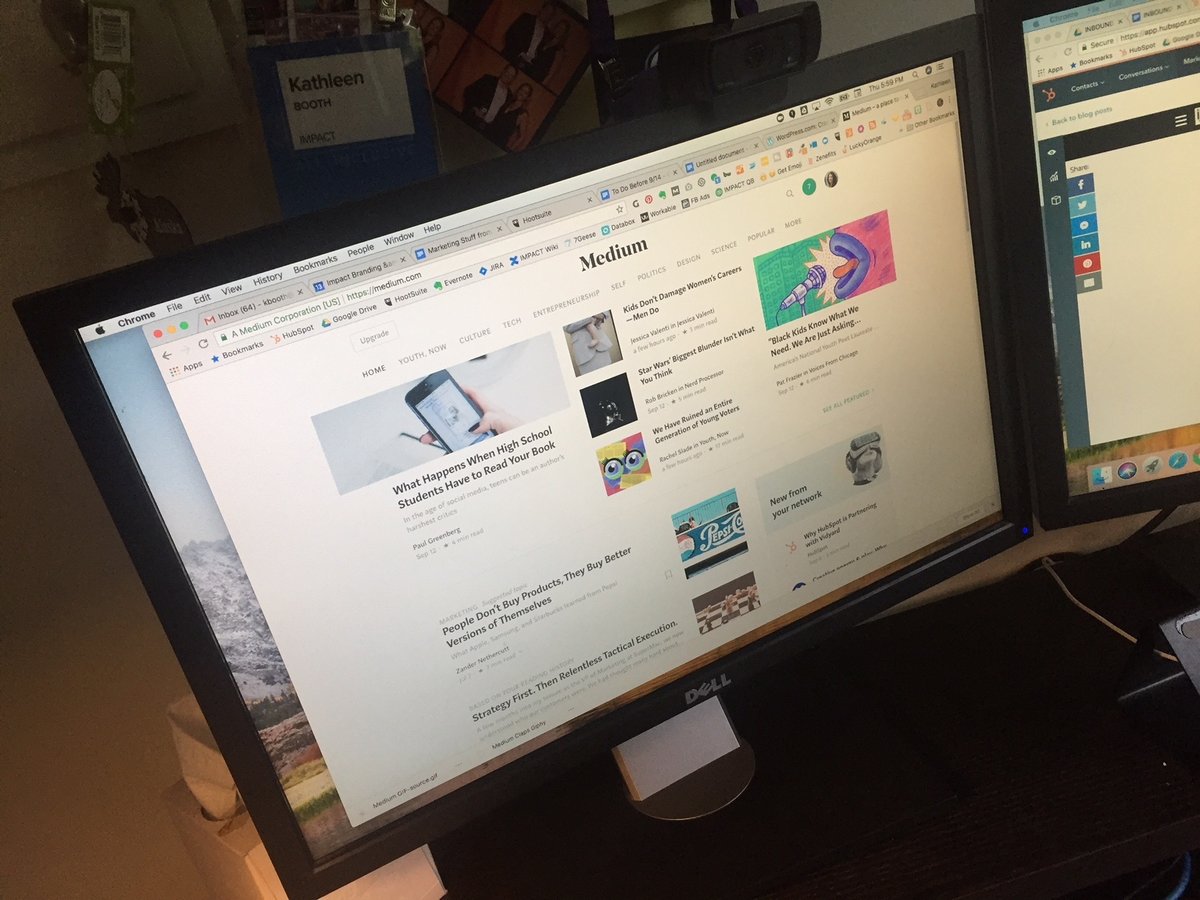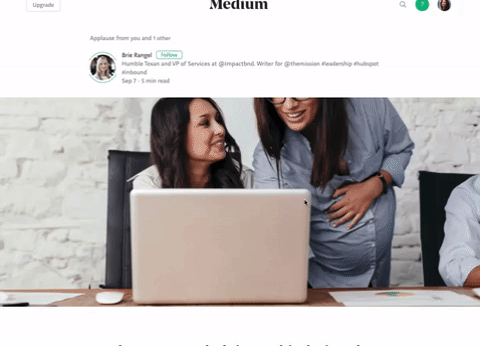Join 40,000+ sales and marketing pros who receive our weekly newsletter.
Get the most relevant, actionable digital sales and marketing insights you need to make smarter decisions faster... all in under five minutes.
Blogging Strategy: When Should You Consider Publishing on Medium?

Sep 14, 2018

I’m a marketer who is definitely guilty of shiny object syndrome.
I see something new and my first thought is almost always “Ooh, I need to do that!”
Then, very often, that thought is followed by me putting whatever I happen to be working on aside and jumping on said new thing at the expense of the 1,000 other priorities on my daily to do list.
Sound familiar?
Unfortunately (or fortunately, depending upon how you look at it), there will always be a steady stream of new tools, tactics, platforms, and strategies to disrupt our daily marketing routines.
The question we really need to ask ourselves is, “Will the results I can potentially get from this really justify the time and effort?”
I’ve been having this exact internal dialogue for about two years now with respect to Medium.
It is that shiny object that just won’t go away and like a moth to a lightbulb, I can’t seem to ignore it.
At this year’s INBOUND conference, I attended a presentation by Janessa Lantz, the editor of HubSpot’s “Think Growth” publication on Medium, that finally gave me the clarity I needed to put Medium in perspective and make an informed decision about whether and how I should include it in IMPACT’s marketing mix.
But first…
What Medium Is (and Isn’t)
Medium calls itself “a place to read and write big ideas and important stores.”
It positions itself as a publishing platform which, in marketing terms, you might be tempted to think of as a content management system (CMS) (like WordPress and HubSpot).
Ignore that temptation.
While Medium has many of the characteristics of a CMS (i.e. you can easily publish articles or stories using a web-based editor), it is different in one very important way.
While the typical CMS is built for creating and maintaining website pages and blogs (articles) that are optimized for search engines and therefore designed for visitors who are in “search mode,” Medium is built for creating long-form content that is optimized for virality and therefore designed for visitors who are in “discovery mode.”
There’s a big difference between the two.
When you publish on Medium, you’re not actually publishing on a content management system, you’re publishing on a social network of sorts.
In fact, Medium is the ONLY place on the internet where long-form content can go viral.
Think about that for a minute…
![]()
If, like me, you are a practicing inbound marketer, then, odds are, you’re investing in the creation of a LOT of long-form content.
Whether you’re producing blogs, eBooks, white papers, or pillar content, this stuff takes a whole lot of time and and effort to create, so who wouldn’t love the idea that it could go viral?
I know I love it. Yeah, virality! Sign me up for that!
So, publishing on Medium sounds like a no brainer, right?!
Not so fast…
What It Takes to Go Viral on Medium
Any experienced marketer knows that generating traffic to a blog requires either great SEO or an existing audience of subscribers (and usually some combination of the two).
What this means is that if you want your blog posts to reach a new audience, there has to be search volume around the keywords you are targeting.
After all, if no one is searching for “how to make anchovy cookies” then the best copywriting and SEO in the world probably isn’t going to generate a flood of new visitors.
By contrast, on Medium, you can publish content that is not at all search optimized and still have it go viral.
How is this possible?
The secret lies in Medium’s algorithm.
Remember, Medium is really a social network disguised as a content management system.
On Medium, when someone likes an article, they give it a clap.

A clap on Medium is like hitting the “like” button on Facebook, except each individual Medium user can clap up to 50 times for a single post.
If you want your content to be seen on Medium, you have to start by getting claps.
Fortunately for the rest of us, HubSpot (well, really Jessica) has invested serious time into figuring out what does and does not drive results on Medium.
The tests they’ve conducted have revealed that you have to get 50 individual fans to clap for your article (as opposed to 50 claps from one fan) in the first 24 hours after it is published if you want your post to get even the most basic visibility.
Without that, you’re basically dead in the water.
To be clear, claps from 50 individual fans is not a home run - it is merely how you get “at bat.”
If you can get those first 50 people to give your article a clap, then it's really about making an all out push to see how many more claps you can get in the shortest possible time.
How to Get Claps on Medium
If you are reading this and expecting there to be some sort of magic bullet for getting claps, I'm sorry to tell you that you are going to be sorely disappointed.
While there is no Medium “easy button” (if there were, everyone would already be pressing it, right?), there are a number of things you can do to dramatically improve your odds:
- Promote your Medium post on LinkedIn: Any time HubSpot publishes on Medium, if the article is by a member of HubSpot’s executive team, they also post a status update on LinkedIn about what the article covers. Because these individual authors have big LinkedIn followings, this helps generate an initial flow of traffic to the Medium post.
- Email a link to the article to all of your friends, followers, etc.: The best way to get a clap is to ask for it. If you’re the author of the post, send a note to your network with a link to the post and a clear “ask” for claps. If you are not the author, send an email to whoever contributed the post asking them to promote it to their network - and make it as easy as possible for them to do so by providing sample email or social copy. At HubSpot, the Medium posts that get the most claps are written by contributors who put a ton of personal effort into article promotion.
- Slack out a link internally: Unless you’re a one-man (or woman) band, you’ve got colleagues who can help with article promotion. Send a message to your team (using Slack or email or whatever internal chat platform you use) asking them to show your article some love.
- Tag your Medium post: Adding relevant tags to your post can help it get found by Medium users. Not only will a tagged post be distributed on the relevant tag pages (like a homepage for the tag topic), when a Medium user searches for one of the tags you’ve used in your post, it will appear higher in the platform's search results. Medium allows you to use up to five tags per post, and the most popular (at this time) are #tech, #life-lessons, #travel, #design and #startup. You can also use MediumTags.com, a free tool, to surface the best tags for your post.
All of the strategies I’ve listed above will work if - and only if - you have actually created content that people are going to find interesting and share worthy.
Think about it this way: If all of your friends aren’t likely to be interested in your post, it is probably not worth publishing.
By contrast, if you’ve created great content and you’re confident that your network will find it interesting, a little elbow grease when it comes to article promotion can go a long way.
How to Know if Publishing on Medium is Right for You
Before you can determine whether publishing on Medium is right for you, you need to identify the specific goals you’d like to achieve.
Medium is NOT a great place to publish if your goal is:
- Increased visitor traffic to your website: Medium won’t help your website SEO and it is not designed to drive Medium users off the platform.
- Lead generation: Medium doesn’t have built in tools for adding calls-to-action to your posts and articles that are full of CTAs don’t tend to do well.
Medium IS a good platform for:
- Increasing brand awareness: Because Medium is optimized for discovery, odds are that your articles will get in front of a new audience. In HubSpot’s case, an analysis of the company’s 200,000 Medium followers revealed that more than 87% were not currently in its contact database (pretty incredible when you consider the size of HubSpot’s database).
- Expanding the reach of your content: If you’re already creating great content that has been published on another channel, repurposing it for Medium can be an easy - and quick - way to get it in front of a larger audience. For example, when HubSpot CoFounder Dharmesh Shah spoke at the company’s INBOUND conference in 2017 about what he learned from Elon Musk, the team at HubSpot turned his talk into a Medium post that has gotten more than 10,000 claps.
Like most social networks, Medium has evolved quite a bit over the last few years and my expectation is that it will continue to change in the years to come.
Just as Facebook has moved in the direction of more aggressively monetizing its platform, Medium has begun to experiment with paid content on its homepage and in its newsletter.
It’s impossible to predict what the Medium of tomorrow will look like, but for today, the platform holds interesting potential for using long form content to achieve virality - something that is really not possible anywhere else on the internet.
As for me, I’ve decided to hold off on investing time in Medium this year. But like that moth that is perpetually drawn to the flame, I’m sure I’ll be back to check it out again soon!
Free Assessment: